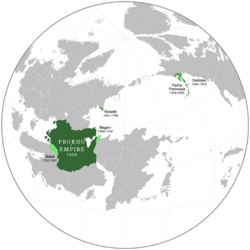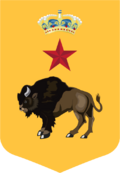Prokho Empire
This article is incomplete because it is pending further input from participants, or it is a work-in-progress by one author. Please comment on this article's talk page to share your input, comments and questions. Note: To contribute to this article, you may need to seek help from the author(s) of this page. |
Prokho Empire Imperitsa Prokho | |
|---|---|
| 1316–1867 | |
| Motto: "Grasteya Avets Peradye" "Honour Always Forefront" | |
| Anthem: "Otsa Imperitsy Mughy!" "Our Imperial Might!" | |
 Directly administrated territory
Protectorates and other territory
Occupied sphere of influence | |
| Capital | Karlivorod (1316–1591) Darovskiya (1591–1867) |
| Common languages | Prokho |
| Religion | Zarov Doxology |
| Government | Absolute monarchy |
| Emperor | |
• 1316–1324 (first) | Karliv I |
• 1834–1867 (last) | Cheslav IV |
| Legislature | the Emperor Imperial Conclave |
| History | |
• Foundation | 26 September 1316 |
• Dissolution | 12 August 1867 |
| Area | |
| 1850 | 5,356,360 km2 (2,068,100 sq mi) |
| Population | |
• 1857 | 112,680,000 |
| Currency | Imperial usvanka |
The Prokho Empire (Prokho: Imperitsa Prokho), also known as the Empire of Prokhovia was an empire that existed from 1316 until 1867 with the abdication of Cheslav IV and relinquishment of power to a democratic government. The empire was one of the longest continuous absolute monarchies.
Founded in 1316 after the rise of nobility in Eastern Esermia, the empire consolidated the scattered republics and kingdoms of Eptadasia, which became known as Prokhovia during imperial conquest. With the foundation of the Eastern Rite of Doxology in the 16th century, Prokhovia became the center for Zarov culture. Rapid expansion towards the east and south in the following centuries made the empire a vital mainland area between Esermia, Siradia and Kimena, leading to both transcontinental development, and political tensions. Contending for control of trade and naval supremacy in the Parazin Sea conflict arose between Prokhovia and the Terado-Murataldi Empire, as part of the larger Blackpowder Wars of the 18th century.
During the 19th century, imperial rule heightened, as did dissent among the populace as the empire focused efforts towards foreign holdings. With economic deterioration, public calls for a shift to a democratic government and the failing health of Cheslav IV, the empire dissolved in 1867 and the Republic of Prokhogorsk was established. Decades after its partitioning and exile of the royal family Prokhovia fell under rule of a Socialist regime and the majority of its Esermian territory comprises that of modern day Prokhogorsk. The empire was one of the largest empires in Esermian history, only surpassed by landmass to the Tlusevian Empire.
Etymology
The term Prokhovia, used as the common short name for the empire, originated from the original ruling dynasty of the House of Prokhov. Referring to the empire as either the Prokho Empire or Empire of Prokhovia are accepted, with the former being adopted for modern day historical writings, and the latter having been commonly used in official royal and legal documentation of the time. Like present day Prokhogorsk, the synonym of the people was Prokho.


